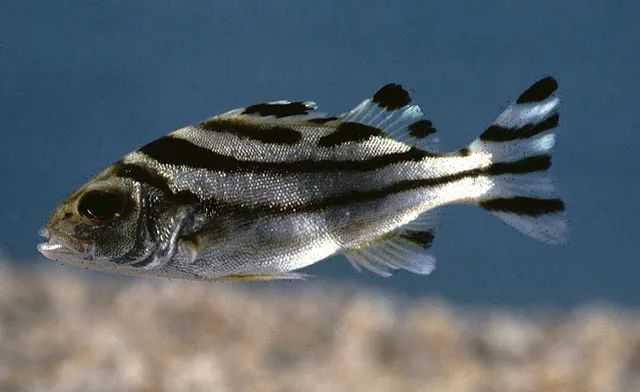
Terapon jarbua, commonly known as the crescent grunter, is a remarkable species within the Terapontidae family. Inhabiting the warm waters of the Indo - Pacific region, this fish is celebrated for its adaptability and ecological significance in coastal and estuarine ecosystems. It showcases a unique appearance and behavioral traits that set it apart in the diverse marine world.
Growing up to 40 centimeters in length, the crescent grunter features a laterally compressed, elongated body. Its body is covered in small, 栉状 scales, giving it a sleek texture. The coloration is a blend of earthy tones, with a dorsal side that ranges from olive - brown to grayish - brown, gradually fading to a lighter, almost silvery shade on the ventral side. A defining characteristic is the presence of three prominent, curved black bands that arch along its body, creating a distinct and eye - catching pattern. The dorsal fin is divided into two parts: a spiny anterior section with XII spines and a soft - rayed posterior part with 10 rays. The anal fin has III spines and 9 - 10 soft rays. These fins, along with its forked caudal fin, enable it to navigate through various water conditions with agility.
This species is highly adaptable in terms of habitat. It can be found in a wide range of environments, from the salty expanse of the open ocean to the brackish waters of estuaries and coastal lagoons, and even penetrates well into freshwater rivers. Juveniles are often seen in intertidal zones, particularly in sandy areas and tidal pools, where they form small groups. As they grow, they become more territorial. The crescent grunter is a carnivorous predator, feeding on a diet that includes smaller fish, crustaceans like shrimp and crabs, and other benthic invertebrates such as worms and mollusks. Interestingly, it also acts as a cleaner fish on occasion, consuming ectoparasites from larger fish, and has been known to eat fish scales, which are rich in calories.
Terapon jarbua plays a crucial role in the food web of coastal ecosystems, serving as both predator and prey. It is an important commercial species within its range, targeted by various inshore fishing gears like gillnets, traps, handlines, and bottom trawls. The fish is sold fresh in local markets or processed into dried and salted forms. Additionally, it is sometimes sought after for the aquarium trade due to its unique appearance, where it is known as the "target fish" for the pattern visible from above. However, like many coastal species, it faces threats from habitat degradation, pollution, and overfishing. Conservation efforts, such as protecting estuarine and coastal habitats and implementing sustainable fishing practices, are essential to ensure the long - term survival of this fascinating crescent grunter.




